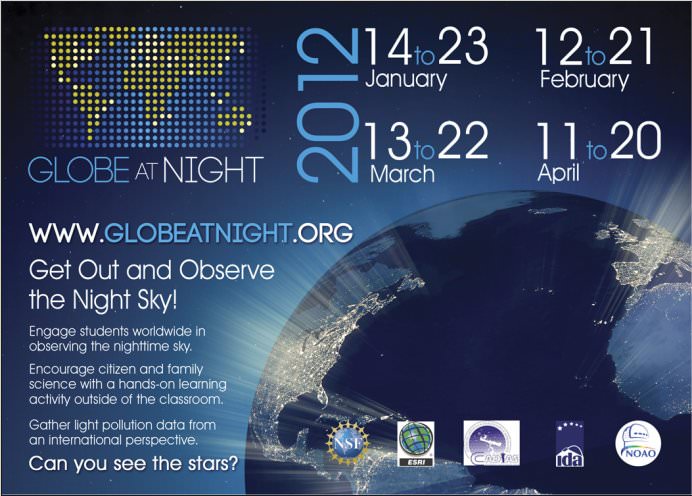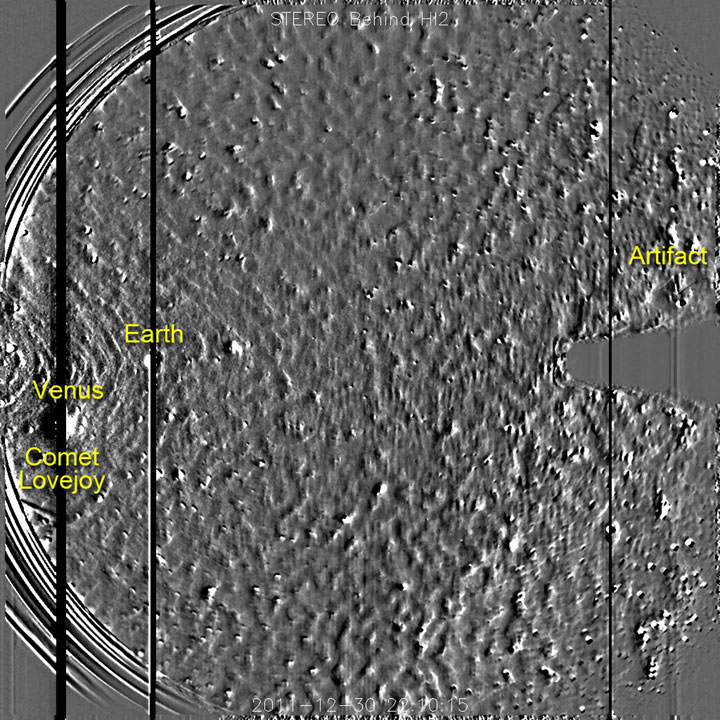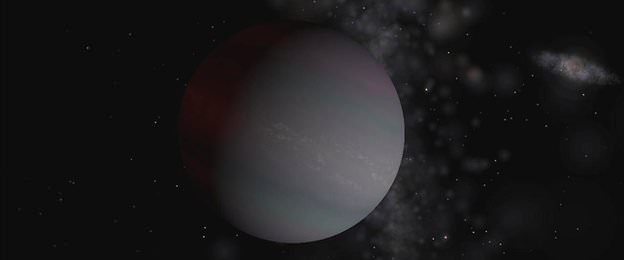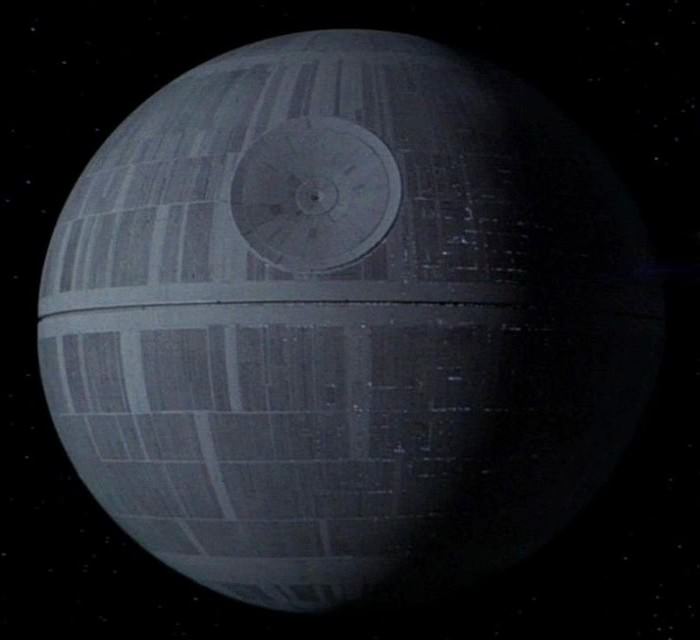Our weekly space hangout continues. This week we talk about boiling planets, re-Pillars of Creation, a galaxy made of dark matter, the return of Phobos-Grunt and a telescope the size of a planet.
Desperately Seeking a Snow Day: Why So Little Snow in 2012?
Ah, for the days of Snowmageddon and Snowpocalypse back in 2010 and 2011. So far, 2012 is turning out to be a dud as far as getting a snow day or two off from work or school. Even though the Pacific Northwest in the US just got a major snowstorm, on the whole the US isn’t seeing much snowfall this winter. Why such a difference in just one year? In this ScienceCast, JPL climatologist Bill Patzert explains what’s going on.
Citizen Science: GLOBE at Night
[/caption]Are you a fan of Citizen Science? Do you enjoy participating in projects that help researchers and possibly the environment?
GLOBE at Night is one such program! By taking naked-eye observations of the night sky in your area, you can help a world-wide effort to track the effects of light pollution.
Here’s all the info you need in order to participate in GLOBE at Night during 2012.
For starters, what is GLOBE at Night?
The GLOBE at Night program is an international citizen-science campaign designed to raise public awareness of the impact of light pollution on our night skies. GLOBE at Night aims to raise awareness by inviting citizen-scientists to measure their night sky brightness and submit their observations to a website from a computer or smart phone.
Light pollution not only threatens our “right to starlight”, but also affects energy consumption, wildlife and health. For the past six years, the GLOBE at Night campaign has been involving people in 115 countries.
Participating in GLOBE at Night requires only five easy steps:
1) Find your latitude and longitude.
2) Find Orion, Leo or Crux by going outside more than an hour after sunset (about 8-10pm local time).
3) Match your nighttime sky to one of the provided magnitude charts.
5) Compare your observation to thousands around the world.
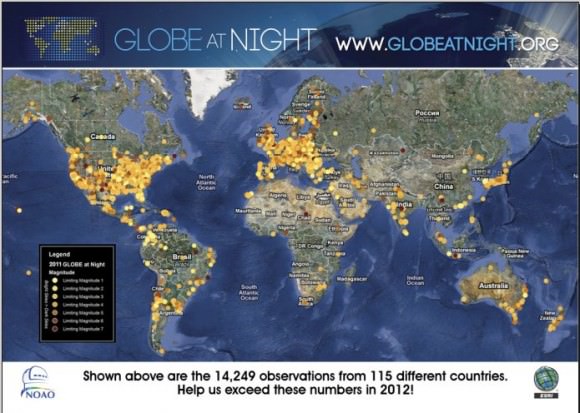
You can also use the new web application data submission process. The GLOBE at Night website is easy to use, comprehensive and holds an abundance of background information. The database is usable for comparisons with a variety of other databases, like how light pollution affects the foraging habits of bats.
If you’d like to learn more about GLOBE at Night, visit: http://www.globeatnight.org/ , or the 365 Days of Astronomy Podcast: GLOBE at Night Kickoff: Seeing the Light.
Aurora Alert! Sun Sends CME in Earth’s Direction
As seen here by the Solar Dynamics Observatory, a long duration M3-class flare began erupting on the Sun from sunspot region 1401 at 13:42 UTC (8:42 AM ET) today, Thursday, January 19, 2012, sending a coronal mass ejection (CME) directly towards Earth. Scientists predict the CME will arrive at around 16:00 UTC on January 21, 2012 GMT. Spaceweather.com says strong geomagnetic storms are possible and high-latitude (and possibly middle-latitude) skywatchers can be on the lookout for increased aurora.
Continue reading “Aurora Alert! Sun Sends CME in Earth’s Direction”
I Thought I Saw A UFO! Mystery Triangle On STEREO Image Explained…
Mystery diamond-shape “object” entering the field-of-view of the HI2 telescope on STEREO Behind around December 26, 2011. Credit: NASA
The STEREO (Solar TErrestrial RElations Observatory) is a two-year mission conducted by NASA. It employs nearly identical twin telescopes – one positioned ahead of Earth’s orbit and the other behind – designed to study the Sun’s activities spectroscopically. However, it can sometimes pick up some very unusual findings! On December 26, 2011, the STEREO Behind Observatory’s HI2 telescope captured an ambiguous triangle entering the field of view and moving from right to left just above the trapezoidal occulter as seen in the above movie. Just what is this “thing”?!
Before you get ready to call the men in black, know that there is a logical answer… and it comes into play on the opposite side of the STEREO image. Play the movie again and watch. (It’s a bit more obvious in this close-up view.) Just as the weird triangle begins its approach, you’ll notice the dazzling Venus enters the field of view of the HI2-B at the same time to the lower left. As you watch, you’ll see they keep exactly the same time – in opposite – across the detector image. This isn’t just a chance happening… it’s a naturally-occurring internal reflection caused by Venus’ brilliance in the telescope’s optics. It might be exciting for the moment, but it’s nothing that hasn’t happened in the past. Just check out these great STEREO Reflections of Earth, and all sorts of other cool images on the STEREO Image Artifacts pages.
[/caption]
What else can be seen? As you can tell from this photograph, Earth is also starring in the show, but doesn’t come in as striking as Venus. What’s more you can also see the tail of Comet Lovejoy streaking in from the left just above Venus towards the end of the movie.
Exactly how do you keep track of what’s going on? Check out the Where Is STEREO? pages for up-to-date information and the totally cool Current STEREO Solar Images!
Original Story Source: Triangular shaped object in STEREO data explained.
British TV Audience Discovers Potential New Planet
[/caption]
A public “mass participation” push initiated on a UK television program to find planets beyond our Solar System has had an immediate result! On Monday, January 16, 2012 “BBC Stargazing LIVE” began its first of three nights of television programs live from Jodrell Bank Observatory in the UK. The series was hosted by Professor Brian Cox, comedian Dara O’Briain along with a number of other well known TV personalities, astronomers and scientists. There was even a guest appearance via satellite link from Captain Gene Cernan, the last man on the Moon.
As well as the main TV program, there were numerous local events across the UK and the viewers could “mass participate” in activities such as looking for extra solar planets with the citizen science project, Planethunters.org.
The website hosts data gathered by NASA’s Kepler space telescope, and asks volunteers to sift the information for anything unusual that might have been missed in a computer search. People are especially adept at seeing things that computers do not and the BBC Stargazing Live event was a golden opportunity to get many people looking. During the event, over a million classifications were made and 34 candidate planets found on the website in 48 hours.
On the last show of the series on Wednesday 18th January it was announced, that in particular, one planet candidate looks extremely promising, as it has been identified multiple times by PlanetHunter participants.
The planet is circling the star SPH10066540 and is described as being similar in size to Neptune, circles its parent every 90 days and is about a similar distance from its parent star as Mercury is from our Sun. It could be described as a hot Neptune.
Chris Holmes from Peterborough UK and Lee Threapleton also from the UK found the planet by searching through time-lapsed images of stars looking for the periodic dips in brightness that result every time a planet passes in front of (transits) one of those stars.
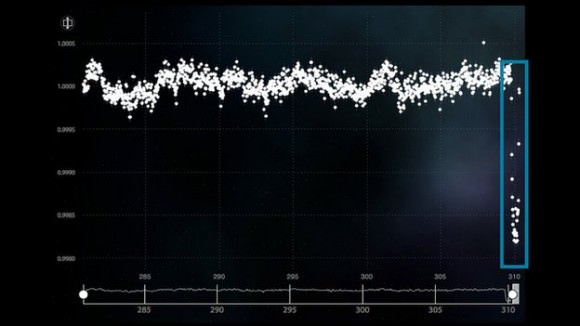
A transit has to be observed several times before a planet will be confirmed. For the orange dwarf star SPH10066540, five such events have now been seen in the Kepler data making it a strong candidate for an extra solar planet.
“There’s more work to be done to confirm whether these candidates are true planets,” wrote the PlanetHunters team on their blog, “in particular, we need to talk to our friends on the Kepler team – but we’re on our way.”
The NASA Kepler space telescope, launched in 2009, has been searching a part of space thought to have many stars similar to our own Sun.
You can try and find a new planet too by visiting planethunters.org it is incredibly simple and easy to do and requires no previous knowledge of astronomy.
How many more planets will be discovered?
Who Will Be the Next Astronomy Photographer of the Year?
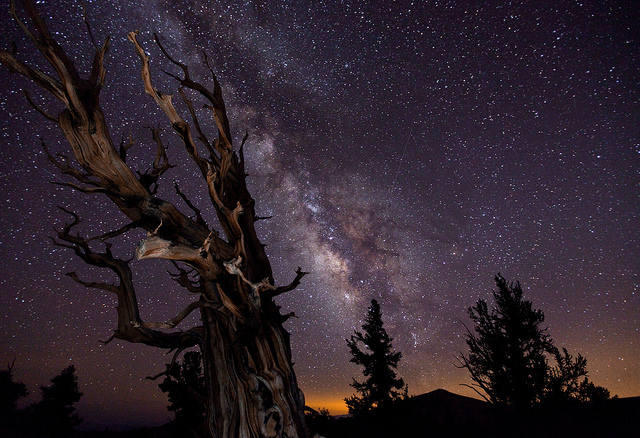
[/caption]
Attention all astrophotographers (as well as those of us who just enjoy looking at great astronomy images!): The Royal Observatory Greenwich is launching its annual Astronomy Photographer of the Year competition, and is searching for the most beautiful, dramatic and spectacular images of the cosmos. Anyone from around the world can enter and the winning images will be showcased at the Royal Observatory.
This is the 4th year of this competition, which began as part of the International Year of Astronomy in 2009.
“Astronomy is becoming increasingly popular with the public which is reflected in the big rise in entries we saw in 2011,” said Dr. Marek Kukula, Public Astronomer at the ROG. “Every year the competition has brought new surprises, I love the fact that we receive entries from people all around the world and from complete beginners as well as seasoned experts. All the judges are excited about what we’re going to see this time around.”
Astronomy Photographer of the Year 2012 has four main categories:
Earth and Space – Photographs that include landscape, people and other earth-related things alongside an astronomical subject ranging from the stars, the Moon or near-Earth phenomena such as the aurora.
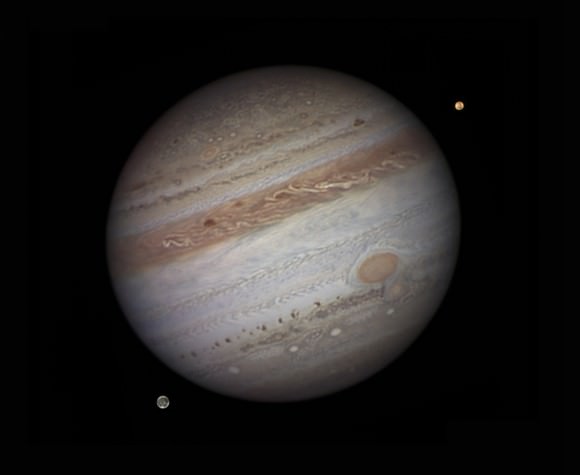
Our Solar System – Imagery which captures the Sun and its family of planets, moons, asteroids and comets.
Deep Space – Pictures that capture anything beyond the Solar System, including stars, nebulae and galaxies.
Young Astronomy Photographer of the Year – Pictures taken by budding astronomers under the age of 16 years old.
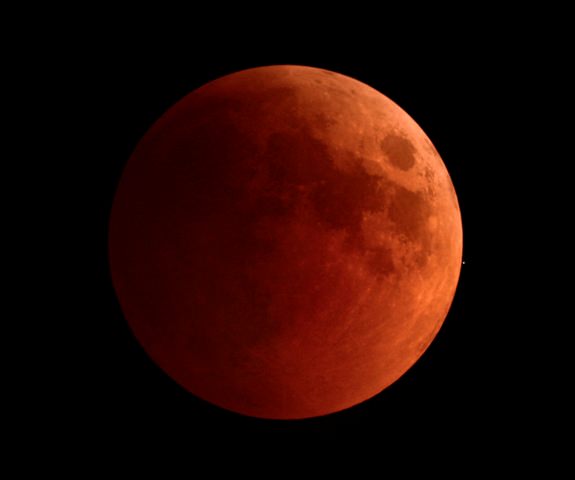
There are also three special prizes:
People and Space recognizes the best photo featuring people in the shot;
Best Newcomer is awarded to the best photo by an amateur astrophotographer who has taken up the hobby in the last year and who has not entered an image into the competition before;
Robotic Scope, which was a new prize introduced in 2011, is awarded for the best photo taken using one of the increasing number of computer-controlled telescopes at prime observing sites around the world which can be accessed over the internet by members of the public.
Entries to the competition must be submitted by midday on June 29, 2012, with the winners announced on September 20, 2012. The winning photos will be displayed at the ROG from September 21, 2012 to February 2013.
The overall winner will receive £1,500. Category winners will receive £500. There are also prizes for runners-up (£250) and highly commended (£125) entries. The Special Prize winners will receive £350, with an £125 prize for the People and Space Special Prize runner-up. All of the winning entries will receive a one year subscription to Sky at Night Magazine, which is also a sponsor of the competition.
The competition is powered by the photo-sharing website Flickr. To view the entries online please visit www.flickr.com/groups/astrophoto
Photographers can enter online by visiting www.rmg.co.uk/astrophoto and each entrant may submit up to five images to the competition.
Good luck, and we hope to be posting YOUR winning image here on Universe Today!!
A New Look at the Helix Nebula — a Giant “Eye” in Space
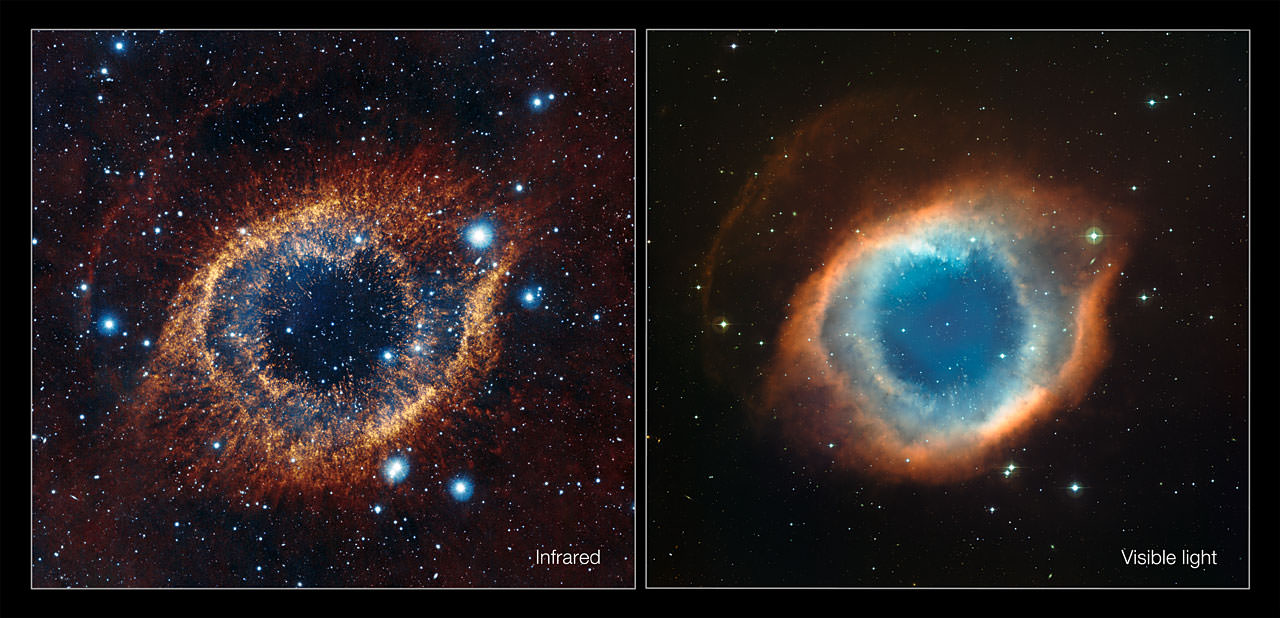
[/caption]
Who is looking at who here? A brand new image of the Helix Nebula (breathlessly called the “Eye of God” in viral email messages) was taken by ESO’s VISTA telescope, at the Paranal Observatory in Chile. In infrared light — compared previous images of the Helix Nebula taken in visible light — the “eye” appears to have put on a colored contact lens, changing the color from blue to brown. What infrared really reveals are strands of cold gases within the nebula, as well as highlighting a rich background of stars and galaxies.
The Helix Nebula is a planetary nebula, and is located in the constellation Aquarius, about 700 light-years away from Earth. This strange object formed when a star like the Sun was in the final stages of its life. In fact, our own Sun might look like this one day, several billion years from now.
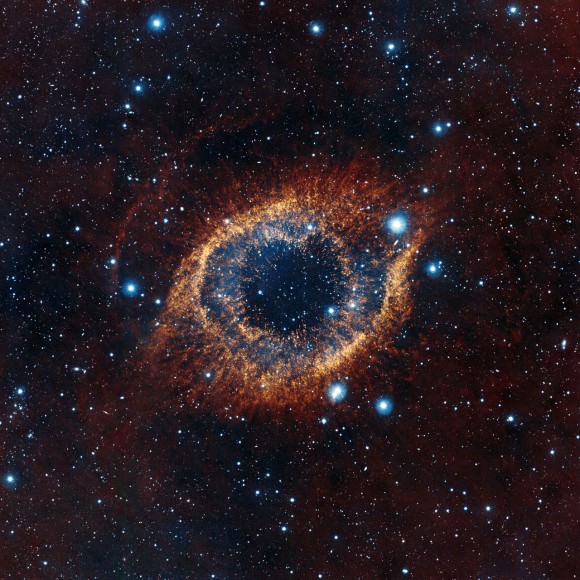
The Helix Nebula is a huge cavern of glowing gases. The main ring of the Helix is about two light-years across, roughly half the distance between the Sun and the nearest star. However, material from the nebula spreads out from the star to at least four light-years. This is particularly clear in this infrared view since red molecular gas can be seen across much of the image.
At its center is a dying star which has ejected masses of dust and gas to form tentacle-like filaments stretching toward an outer rim composed of the same material. Unable to hold onto its outer layers, the hot central star is slowly shedding shells of gas that became the nebula. It is evolving to become a white dwarf star and appears as the tiny blue dot seen at the center of the image.
The VISTA telescope also reveals fine structure in the nebula’s rings. The infrared light picks out how the cooler, molecular gas is arranged. The material clumps into filaments that radiate out from the center and the whole view resembles a celestial firework display – or a giant eye.
Source: ESO
Deadly Costa Concordia Shipwreck Captured in Stunning Image from Space
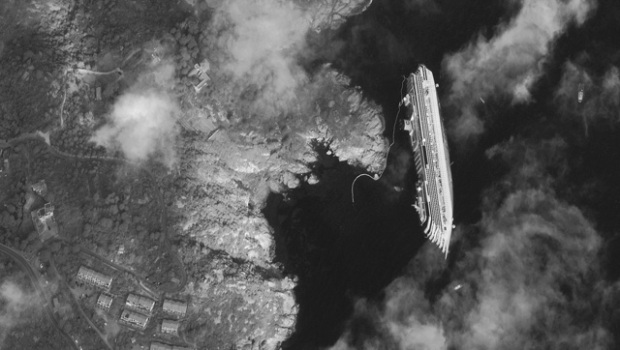
[/caption]
The deadly Costa Concordia shipwreck has been captured in a stunning high resolution image from space that vividly shows the magnitude of the awful disaster with the huge luxury cruise ship precariously tipped on its side just off of the Tuscan coastline of the Italian Island of Giglio [Isola del Giglio]. See the full image and close-up below.
The newly released image was taken by a commercial owned by DigitalGlobe and flying some 300 miles overhead in low Earth orbit. The photo from a WorldView satellite was snapped on January 17, 2012 and shows exactly where the cruise ship ran aground five days ago on Friday, January 13, 2012 when it was steered way to close to the shoreline.
The photo is a surreal view of the massive ship on its side, submerged on the shoreline in the Mediterranean Sea snapped through scattered clouds. The sight is something really hard to believe – imagine the movie Titanic.
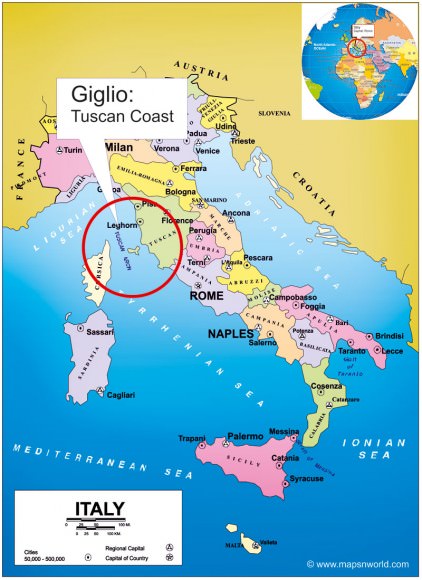
off the Tuscan coastline of Giglio, Italy
The Costa Concordia cruise ship had just left port with over 3200 passengers and 1000 crew members aboard and was sailing extremely close to Giglio Island when it apparently struck underwater rocks that suddenly ripped a gigantic gash through the hull and capsized the ship, sending the terrified passengers scrambling for their lives.
The Mediterranean waters temperature was about 57 F.
Shocking infrared video shows people frantically crawling over the side of the listing ship – tilted completely on its side – frantically trying to get into the lifeboats using rope lines – at night.
Passengers said it was an “Out of body experience.” Strangers helping strangers
Amazing new video shows the rocks clearly embedded in the hull of the wrecked ship.
The ship soon began listing off the Italian coastline in darkness. At a moment’s notice objects started flying through the air and the frightened passengers boarded lifeboats as fast as they could, apparently with no practice training beforehand.
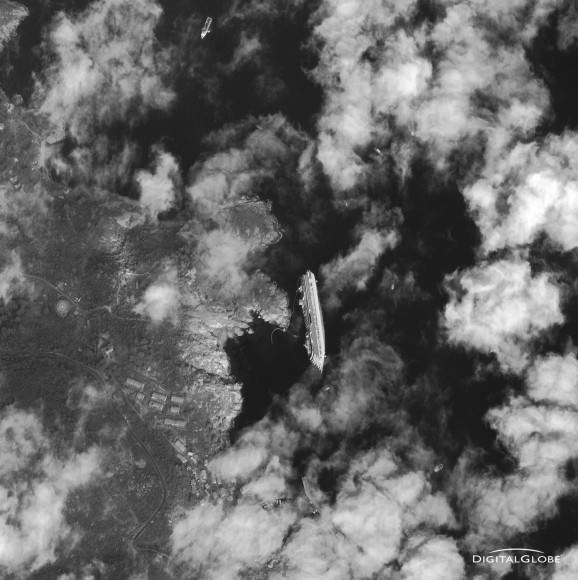
The Costa Concordia luxury cruise ship ran aground in the Tuscan waters off of Giglio,Italy on Friday, January, 2012. Giglio Island at left, the Mediterranean Sea at right. Credit: DIGITALGLOBE
11 people are confirmed dead so far and about two dozen people are still missing today as emergency rescue crews furiously search every nook and cranny on the cruise ship in a desperate bid to find anyone who may still be alive.
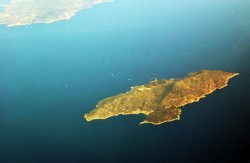
Click to enlarge
Rescues divers have used explosives to gain entry to portions of the ship searching for any survivors.
Rescue efforts were temporarily suspended today (Jan. 18) due to rough seas. The Costa Concordia is loaded with several thousand gallons of diesel fuel oil which could contaminate the surroundings.
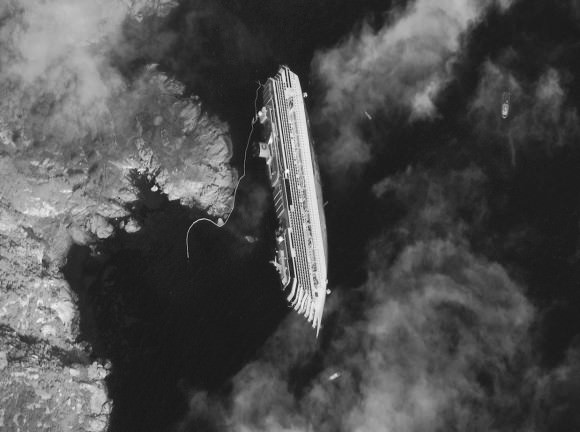
According to the DigitalGlobe website, the Colorado based company owns and operates the most sophisticated constellation of high-resolution commercial earth imaging satellites – . QuickBird, WorldView-1 and WorldView-2 which are capable of collecting over 500 million km2 of quality imagery per year with high resolution cameras.
The DigitalGlobe satellites are used for defense and intelligence, civil agencies, mapping and analysis, environmental monitoring and oil and gas exploration.
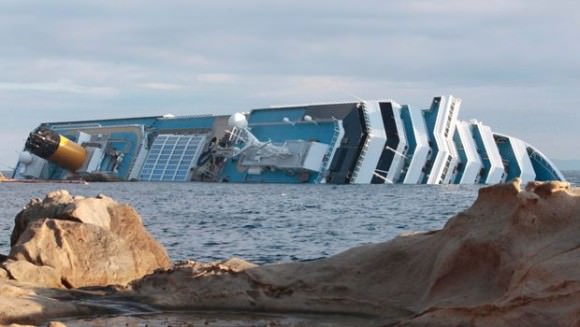
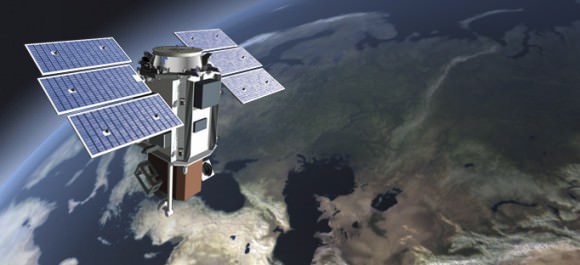
Now look in the opposite direction and see fabulous photos of the ISS crossing the Moon shot from a telescope in Houston, Texas
Dazzling Photos of the International Space Station Crossing the Moon!
Could a ‘Death Star’ Really Destroy a Planet?
[/caption]Countless Sci-Fi fans vividly remember the famous scene in Star Wars in which the Death Star obliterates the planet Alderaan.
Mirroring many late night caffeine-fueled arguments among Sci-Fi fans, a University of Leicester researcher asks the question:
Could a small moon-sized battle station generate enough energy to destroy an Earth-sized planet?
A paper by David Boulderston (University of Leicester) sets out to answer that very question. First, for the uninitiated, just what the heck is a Death Star?
According to Star Wars lore, the DS-1 Orbital Battle Station, or Death Star, is a moon-sized battle station designed to spread fear throughout the galaxy. The image above shows the Death Star as it appeared in Star Wars Episode IV: A New Hope (1977). The Death Star’s main weapon is depicted as a superlaser capable of destroying planets with a single blast.
Boulderston claims that it is possible to estimate how much energy the Death Star would need in order to destroy a planet with its superlaser. There are a number of assumptions made, however, in order to come up with the energy requirement.
For starters, Boulderston assumed that Alderaan did not have any sort of planetary “deflector” shield. A second assumption is that the planet is a solid body of uniform density – essentially ignoring the complex interior of planets, due to lack of information on Alderaan itself. Using the idealized sphere model based on Earth’s mass and diameter, it was possible to determine the gravitational binding energy of Alderaan, using a simple equation of:
U= 3GMp2
——
5Rp
Where G is the Gravitational Constant (6.673×10-11), Mp is planet mass, and Rp is the planet’s radius. Using Earth’s mass and radius, the required energy comes out to 2.25 x 1032 Joules. Using Jupiter’s data, the energy required goes up to 2 x 1036 Joules.
Boulderston asserts that (according to Star Wars lore) the Death Star is powered by a ‘hypermatter’ reactor, possessing the energy output of several main-sequence stars. Given that the power output of our Sun is about 3 x 1026 Joules per second, it’s a reasonable assumption the Death Star’s reactor could power the superlaser.
Despite using a simplified model of a planet, Boulderstone states the simplified model is reasonable to use since the Death Star’s main power reactor has the energy output equal to several main-sequence stars. Even if Earth’s exact composition were used in the equation above, the required energy to destroy a planet would only be affected by a few orders of magnitude – well within the Death Star’s power budget.
Boulderstone reiterated that the energy required to destroy a Jupiter-sized planet would put considerable strain on the Death Star. To destroy a planet like Jupiter, all power from essential systems and life support (no re-routing from the auxiliary EPS conduits – that’s a Star Trek hack!) would be required, which is not necessarily possible.
Boulderstone’s conclusion is that the Death Star could indeed destroy Earth-like planets, given its main power source. While the Death Star could destroy an Earth-sized planet, a Jupiter-sized planet would be a tough challenge, and the Galactic Empire would need to resort to using a Suncrusher to destroy stars.
If you’d like to read Boulderstone’s paper, you can access it at: https://physics.le.ac.uk/journals/index.php/pst/article/view/328/195

